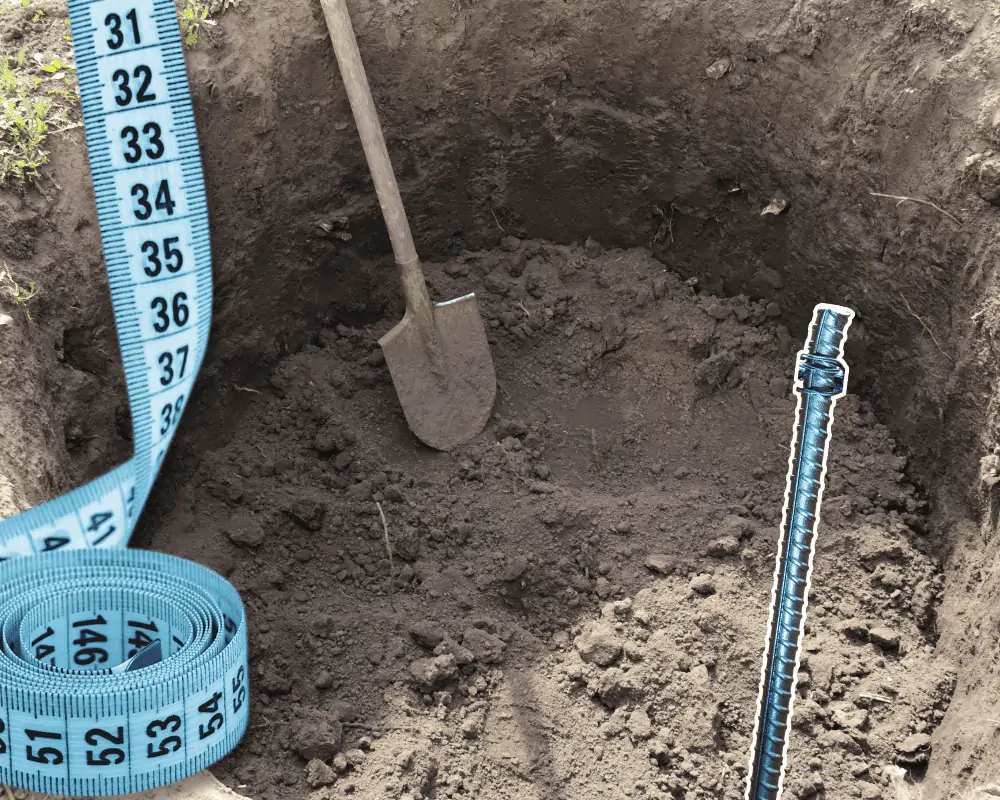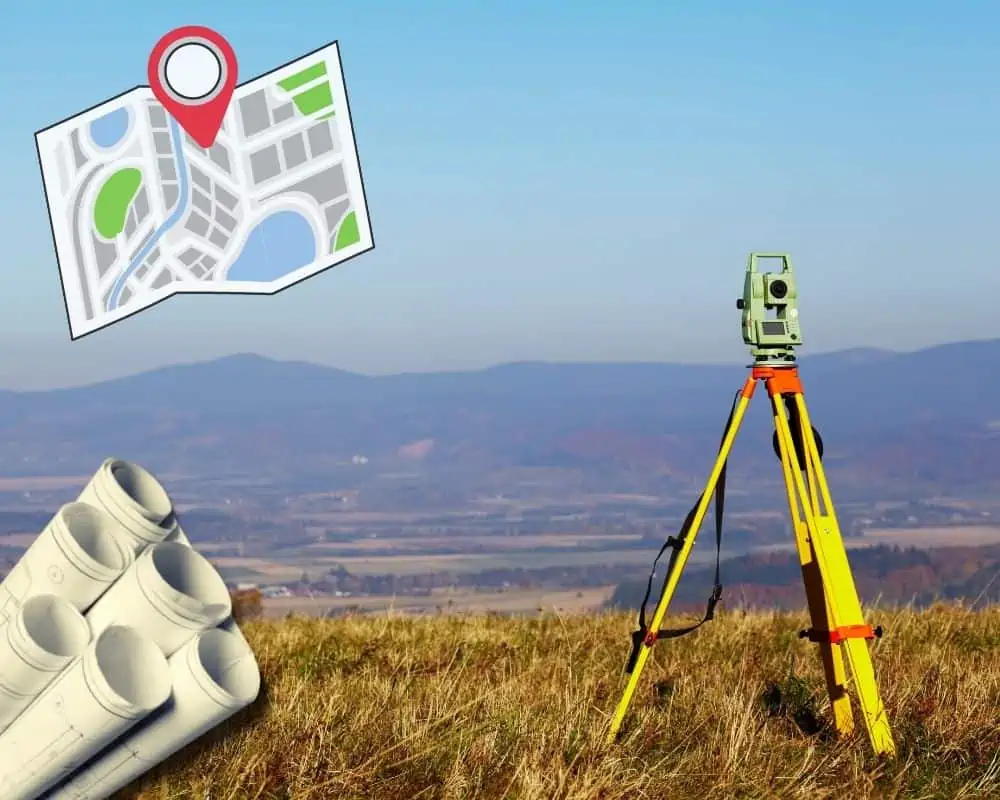Welcome homeowners and treasure hunters! So, you’re looking to find some property lines, eh?
It can be a bit daunting, for sure. But locating property boundaries is crucial if you’re looking to construct your own fence or just need to know where your metal detecting adventure ends.
Regardless of the reason, the solution is easy. Better yet, there is a multitude of resources available to you.
Finding property lines is made simple by using the GPS on your cell phone, a quick check on Google Earth and Google Maps, or metal detecting along the property borders.
Each method offers a unique way of marking up the pins and boundaries.
But these are just a few of the options you have.
Keep reading to learn about the others and get a complete walkthrough.
I’ve done it before, which means you can too!

What Is a Property Pin?
Before I throw you in the deep end, let’s ensure you understand the fundamentals.
Otherwise, the tips laid out below might do more harm than good.
To start, what is a property pin?
A property pin is a metal rod, usually two or three feet long, driven into the ground at each corner of a parcel of land.
The purpose of the property pin is to mark the parcel’s corners so that it can be easily located by surveyors, engineers, and others who need to know its precise location.

So you can avoid any confusion, a property pin can also go by the name property marker, survey pin, property stake, or some variation.
You might be wondering why it’s necessary to know the property line’s location.
Well, for several reasons, actually.
If you’re a metal detectorist, you want to know if what you found can be kept.
Imagine if you started hunting on some farmland (after getting permission), and a couple of hours later, you dig up an old colonial copper to add to your collection.
The only problem is that the farmer tells you that you wandered too far and dug up that coin on someone else’s land.
Whoops.

Property line locations are also needed when adding new elements to the land.
For instance, maybe you build a tree house for your kids in the backyard. It’s awfully close to that midway point between you and the neighbor, isn’t it?
Better make sure that tree is on your land before old Mr. Wilson gets curious and demands you take it down.
That was a Dennis the Menace reference, by the way.
Whatever the reason, you found yourself here. So let’s get back to it.
Are Property Pins Accurate?
The older a home or settled property is, the less accurate the property pin location will be.

As you can imagine, after years underground, these pins may have been disturbed due to the displacement of the soil.
This can happen with little effort. Property markers get moved all the time thanks to landscaping projects and construction work.
If you’ve ever seen a utility crew out around your house, you can bet they’re installing cables and pipes near the markers.
I mean, how often do you see them digging up right through the middle of a yard?
They won’t if they can avoid it. Any underground installation usually runs perpendicular to the property line, which can often be public property.
How Deep Are Property Pins?
Property pins are generally just below the surface or sometimes a foot deep, so they’re not too difficult to find.

Again, as long as they haven’t been accidentally removed or too far displaced.
Yes, I did say removed.
If you don’t have any luck finding the property pins, it could be because someone has moved them or tossed them aside.
While the new placement of survey pins is repeatedly from accidental digging, carelessly discarding them isn’t uncommon.
When a landscaper or utility worker realizes what they’ve dug up, you hope they would place the property pin back or bury it relatively close.
But, sometimes, tossing it away is the unfortunate outcome.
In this case, you can try searching for the property corners using a good metal detector for property pins.
But we’ll get more into that later.
How to Find Pins on Property Lines

So how do you find the pins on your property lines?
Before you continue to the 6 easy ways available, I’ve got some general advice to keep in mind.
It’ll help, trust me.
Returning to the accuracy of survey markers, while searching for property pins with your metal detector, remember that they are frequently located several feet away from the actual property line.
The property line is typically set back a certain distance from the street or other boundary. So, if you find a property pin close to the road, the property line is probably even closer!
Also, the metal used for property pins is usually iron.

So if you use a metal detector, ensure you’re using the proper settings.
And regardless of what method you use to locate them, just be careful when digging to verify it’s the property stake.
The two or three-foot rods can be dangerous.
How to Find Property Lines: 6 Easy Ways
So far, so good, right?
You know what property lines and pins are and why you need them.
Now, you’ll learn some methods of finding property lines.
Finding property lines can be found by obtaining a copy of the land survey, checking property lines on Google Maps, locating the property pins around the site, or using a GPS service with mapping software.

You’ll learn more about each of these options in a moment.
But the most direct way to find property lines is by looking at a survey of the land.
The problem with this method is that it can be challenging to understand unless you are a professional surveyor.
For example, where would you even obtain a copy of a land survey?
If this is your property we’re talking about, and you have your mortgage documents, your lender may have given you a copy.
If it’s not your land, you can still access public maps and boundary information from one of the below sources.
So, let’s not waste more time and discuss some of these options.
How to Find Your Property Lines for Free

Getting the property line details for free can quickly be done by visiting the county offices that keep the history of all the ownership changes and land surveys in the area.
The county office will have the free maps and documents needed to find your property line.
All you need is to know the address or tax ID number of the piece of property you are looking for.
I should clarify that not every county department will hand over this information for free.
Some departments may charge a minimal fee to get access to this data. My suggestion would be to reach out to your local municipality and find out what the case is before making a trip down there.
How to Find Property Pins With a GPS
GPS stands for Global Positioning System.
While purposed initially for military use, this government navigation system, using at least 24 operational satellites, became available to civilians in the 1980s.

By circling the planet two times a day, these satellites collect location data and transmit it to a GPS device to display numerous metrics related to geographical information.
If you have a GPS device, you can use it to find your property line.
This is an excellent option if you’re out in the field and don’t have access to the internet or a plat map.
Don’t let their technology scare you off. If you haven’t had a chance before, you’ll find it very uncomplicated to use.
To begin, you’ll want to find the coordinates of the property corners.
You can do this by inputting the address into a GPS coordinate finder like latlong.net.
Once you have the coordinates, you can input them into your GPS device, which will then navigate you to the closest property corner.

Next, follow the property line in either direction until you reach the next corner.
Repeat this process for all four property corners, and you’ll have the property line mapped out in no time.
An alternative to this would be to use a GPS app on your phone like LandGlide.
LandGlide is an app that allows you to view parcel boundaries, property lines, and owner information for any piece of land in the United States just by pointing your phone at it!
LandGlide currently offers a 7-day free trial, but you’ll have to pay for this information-rich service after.
How Accurate Are GPS Property Lines?

Property line accuracy on a GPS device will vary depending on the application and the home’s age.
The parcel data update schedule plays a meaningful role in the application on your device.
Going back to LandGlide, 90% of the counties are updated year-round, while 70% are done more than once in 12 months.
According to LinkGIS, a Kentucky-based GIS service, the parcel data used on many GPS applications is obtained from detail collected from legal descriptions found on deeds and plats.
Then, it’s crosschecked with aerial views of the property, looking for physical markers, like fencing, to confirm accuracy.
The age of the home is significant because newer subdivisions provide a more recent land survey.

Older properties require more guesswork.
Even with all this impressive technology, GPS accuracy is not as good as a new land survey.
GPS technology will get you on the right track, but depending on your application, you should allow for a five to fifteen-foot discrepancy.
Can I Use Google Earth to Find Property Lines?
So this is a little good news/bad news situation. But let’s get the bad news out of the way first.
No, you cannot find property lines on Google Earth.
While this once was a feature offered for Google Earth Pro (a paid subscription), it’s no longer available since the service became free to all users.
How to See Property Lines in Google Earth

Now for the good news.
With the integration of a parcel data layer called PARLAY 2.0, you can see property lines on Google Earth.
PARLAY 2.0 offers a no-cost trial, but you will have to pay a subscription fee for regular use.
With over 156 million properties in PARLAY’s database, you’ll be able to download their massive parcel data and store it in Google Earth.
Then, whenever you need to view property lines, simply open Google Earth and look up your location.
For a helpful and informative walkthrough, check out the video below.
How to See Property Lines in Google Maps
Yes, you can see property lines on Google Maps.
Google Maps is a web mapping platform provided by Google. It offers satellite imagery, street maps, 360° panoramic views of streets, real-time traffic conditions, and route planning for traveling by foot, car, bicycle, and air.
It’s a great alternative to the traditional GPS device. And the best part is that it’s free to use!
To view the property lines, you’ll first want to open up Google Maps and type in the address of the property you are looking for.
Once the map loads, find the “Satellite” option in the upper right-hand corner and click on it. This will bring up the satellite view of the property.
Next, find the “Labels” option and click on that.

This will show you all the labels for the different features on the map, including the property lines!
Are Google Maps Property Lines Accurate?
The only downside to using Google Maps is that it doesn’t always have the most up-to-date information.
Google being the monopoly they are, only updates data at its discretion. Furthermore, they don’t provide any sourcing information. So we don’t know how they obtain the property line details. And thus, can’t verify it.
If there have been changes to the property lines since the last time Google Maps was updated, you probably won’t see the most accurate information.
Another tidbit to keep in mind; if you don’t see the boundary for the location you’re searching, then Google doesn’t have the details for this piece of land.

You’ll have to go with another route.
How to Find Property Lines With a Metal Detector?
If you’re a metal detecting enthusiast, you can use your metal detector to find property lines!
Even if you’ve never been metal detecting in your life, your backyard is the perfect place to start.
Especially if you enjoy being outdoors and want to get some exercise while you’re at it.
To detect the property lines using a metal detector, you want to search for the property pins around the plot of land.
As you previously learned, property pins are frequently made of iron.

Iron is an exceptional conductor of electricity, which makes it one of the better metals a detector can pick up.
Once you find the first property stake, mark it and move on to the next corner.
When you find and mark all of them, you’ll have a clear image of where your boundaries are.
If you’re hesitant about using a metal detector because you never have before, don’t worry about it.
It’s not as complicated as you think, especially when iron is your primary target.
But if it’ll set your mind at ease, check out my introduction guide. It’s a good resource for novices in need of general technique advice.
How to Find Your Property Lines Online?

Some of the previous methods we discussed fit into this online category. But Google is such a large entity that I felt it needed to be addressed independently.
However, there are other paths through the internet you should look into.
Finding property linen online can be trickier than visiting the local office. The main reason is that some counties don’t have their maps and documents available online.
But this isn’t always the case.
If you check your county website, you may find a GIS (geographical information system) division page where you can use their online mapping tool to give you all the information you need for free.

Another excellent way to find your property line online is through a private company specializing in this type of thing.
Many businesses will charge a small fee to find your property line. One such group is AcreValue.
They have a user-friendly website where you can input an address or tax ID number, giving you a detailed report that includes the property line segments.
It’s a popular option for those in the real estate industry.
“AcreValue has a database of over 40M agricultural parcels and 2.6M sale records dating back to 2014.”
AcreValue
This is a perfect tool for reviewing current plat maps.
A plat map is a map of a parcel of land subdivided into lots, blocks, and/or tracts. It shows the relationship of these divisions to one another and the surrounding streets and highways.
While AcreValue has a free plan, you’ll likely have to upgrade to their minimum paid plan for the necessary information.
How to Survey Your Own Property

Be my guest if you’ve got it in your head that you want to survey your property.
Just know that only a licensed surveyor can set or change your property boundaries legally.
So, as long as this is for curiosity’s sake, good on you!
Now, how do you do it? And what sort of tools do you need?
Regarding supplies to survey your property, you need a cellphone, property documents (preferably a plat map), a compass, new property markers, long measuring tape, and a metal detector (optional).
The first step is to review your property documents. Review the top of this article for a reminder of how to obtain these.

You should find some legal paperwork that indicates where a primary property marker exists.
This could be in the form of a natural landmark or an informative directional instruction, like ‘10 yards due north from the parallel cross streets.’
Whatever it is, collect your supplies and find your way to the starting point.
How to Find Property Lines and Corners With a Cell Phone GPS
If, for some reason, you can’t get a hold of the legal property documents, there are options.
You can use one of the applications I already covered to find property lines and corners with a cell phone GPS, like LandGlide.
Alternatively, other cell phone GPS services are available for a one-time purchase.

For example, you can head over to findpropertylines.com from your cell phone browser and get an aerial screenshot of your property with the lines and corners mapped out.
The average cost for a single property is around $95.00, and it usually takes a day or two to fill your order.
How to Mark Property Lines
When you get to the first marker, try and search for a property pin.
This is where your metal detector comes in handy.
Although, there’s a chance you won’t find the pin. And if not, don’t worry about it. This is all for informational purposes and won’t be legally recorded.

Now, mark the location with a new stake, flag, or even a bit of spray paint on the ground.
Bust out that compass and tape measure to find the following property line and corner.
Your GPS or property document should tell you the directional path to take.
Whether it’s north, south, northwest, etc., use your compass to show the way and start walking the path.
Make sure you carry along that tape measure at a level height. When the tape measure length matches the outlined plat map, stop and search for the next marker.
Again, a metal detector would be an ideal method.
If you can’t find the property pin and are optimistic about your spot, mark the second location.
Now just repeat the process until you’ve walked the entire property line.
How to Have Property Lines Marked

After all that, and you’ve decided it’s just not for you, you do have the choice of getting someone else to mark your property lines.
Hiring a licensed surveyor will allow you to mark your property lines officially and set them with legal authority.
Meaning it’s not just a good guess. And you can be confident on the boundary lines.
Be aware that if you bring in a professional, the cost of hiring a land surveyor can range depending on your location and property size.
As of September 2022, the average cost reported is $525 to hire a land surveyor. However, the maximum price is listed at $1,100.
FAQs About Property Lines

Unless you’re into the real estate industry, I imagine you have some questions. Right?
What is Pinning a Property?
“Pinning a property” is a term or technical jargon for setting property pins along the boundary line or conducting a land survey on a plot.
What Is a Property Index Number (PIN)?
A property identification number (PIN), not to be confused with the pin mentioned earlier, is a reference ID assigned to a parcel of land by the county assessor.
This number is used for tax purposes and to locate online documents registered to that PIN.

While a property PIN can help find general information about a piece of land, it will not give you the precise location of the property line.
You’ll need to find the property pins or corners as described above.
Wrapping Up
So there you have it!
Now you know how to find property lines using a variety of methods. Whether you’re a metal detecting enthusiast or want to see the boundaries of your land for peace of mind, these 6 easy ways should help you get the job done.
I should have mentioned this earlier, but your property lines may not be well-defined or exist if it was settled long ago without transferring ownership.
In this case, you’ll need to consult with a surveyor or land specialist to learn more about the land’s history and boundaries.
However, if you are an experienced pro, you no doubt have the area’s history already figured out!
Thanks for reading, and I hope this guide was helpful.
Until next time, keep those eyes peeled and those detectors humming!





